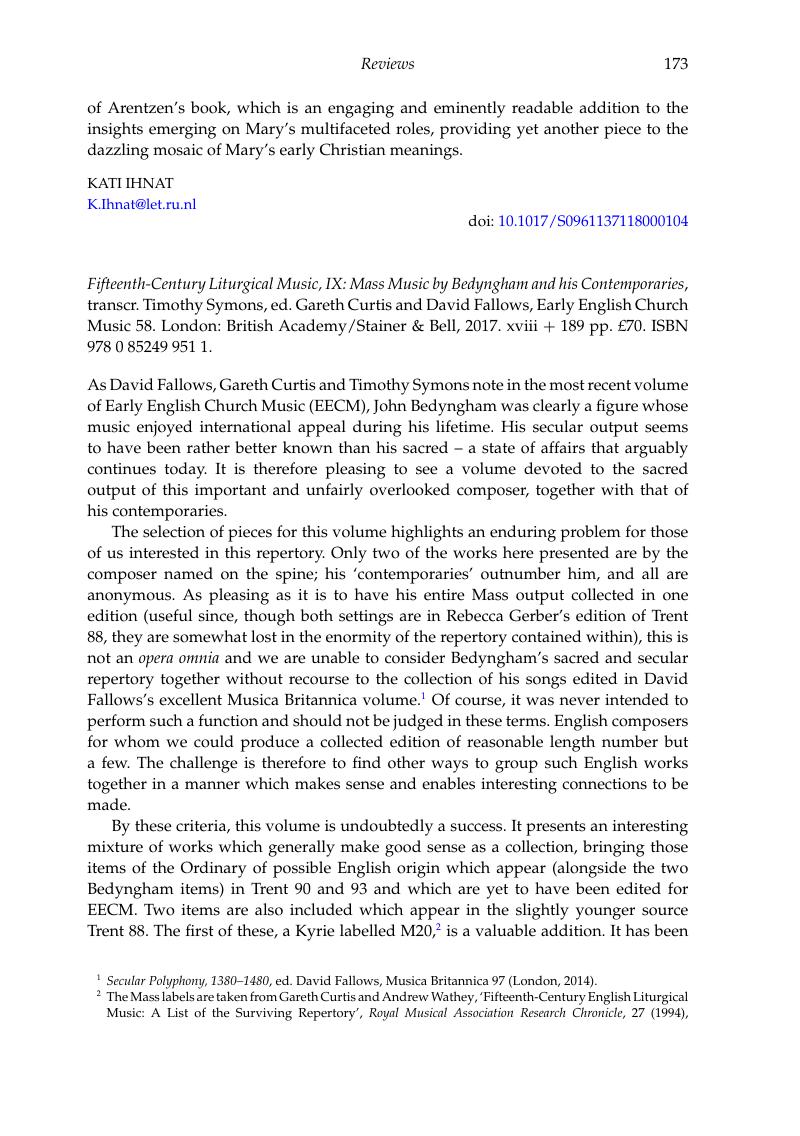No CrossRef data available.
Article contents
Fifteenth-Century Liturgical Music, IX: Mass Music by Bedyngham and his Contemporaries, transcr. Timothy Symons, ed. Gareth Curtis and David Fallows, Early English Church Music 58. London: British Academy/Stainer & Bell, 2017. xviii + 189 pp. £70. ISBN 978 0 85249 951 1.
Published online by Cambridge University Press: 25 October 2018
Abstract

- Type
- Reviews
- Information
- Copyright
- Copyright © Cambridge University Press, 2018
References
1 Secular Polyphony, 1380–1480, ed. David Fallows, Musica Britannica 97 (London, 2014).
2 The Mass labels are taken from Curtis, Gareth and Wathey, Andrew, ‘Fifteenth-Century English Liturgical Music: A List of the Surviving Repertory’, Royal Musical Association Research Chronicle, 27 (1994), 1–69Google Scholar. They are a particularly useful component of this volume and make it far easier to navigate the world of often anonymous, similarly named works. A revised version of the handlist by James Cook and Peter Wright, updated to include more recent scholarship, may be found on the EECM website: www.eecm.ac.uk/sourcesdatabases/database11400-1500/.
3 See p. 73 for an outline of scholarship regarding the Kyrie's relationship to the cycle.
4 The two movements, apparently copied here as a Gloria–Credo duet, appear in what Peter Wright has termed the ‘appendix’ of the manuscript (see ‘Watermarks and Musicology: The Genesis of Johannes Wiser's Collection’, Early Music History, 22 (2003), 247–332, esp. 294–304). In general, Wiser tended not to repeat movements he recognised as part of a cycle between Tr90 and Tr88. That he apparently did so here, and separated out the movements into two groupings in Trent 88, suggests he did not consider this a Mass cycle.
5 For a discussion of voice ranges and grammatical function in the English repertory, see Cook, James, ‘Three-Voice Textures in the Mid-15th-Century English Mass Cycle’, Early Music, 45 (2017), 41–54CrossRefGoogle Scholar.
6 James Cook, The Cyclic Mass: Anglo-Continental Exchange in the Fifteenth Century, RMA Monograph (London, forthcoming) and ‘Mid-Fifteenth-Century English Mass Cycles in Continental Sources’, Ph.D. thesis, University of Nottingham (2014); available through DIAMM.
7 The Duke of Suffolk employed Binchois to compose the rondel Ainsi que a la foiz m'y souvient for him in 1427, whilst in French territories (see David Fallows, ‘Binchois [Binchoys], Gilles de Bins [Binch, Binche] dit’, The New Grove Dictionary of Music and Musicians). Binchois's Vostre tres doulx regart is mentioned twice in the works of the English poet Skelton, and its tenor is found in the Ritson manuscript and Harley 1512 (see Wright, Peter, ‘Binchois and England: Some Questions of Style, Influence, and Attribution in his Sacred Works’, in Binchois Studies, ed. Kirkman, Andrew and Slavin, Dennis (New York, 2000), 87–8)Google ScholarPubMed. Binchois's music also has several instances of often reciprocal borrowing with English works. Power's motet Anima mea liquefacta est borrows from Binchois's De plus en plus (see Burstyn, Shai, ‘Power's Anima Mea and Binchois’ De Plus en Plus: A Study in Musical Relationships’, Musica Disciplina, 30 (1976), 55–72Google Scholar; cited in Wright, ‘Binchois and England’, 88, fn. 4). A Kyrie once thought to be of English provenance appears to quote from Binchois's songs De plus en plus and Se j'eusse un seul peu d'esperance (see Monson, Craig, ‘Stylistic Inconsistencies in a Kyrie Attributed to Dufay’, Journal of the American Musicological Society, 28 (1975), 245–67CrossRefGoogle Scholar; cited in Wright, ‘Binchois and England’, 88. This Kyrie is discussed at length by Wright, Peter in ‘Englishness in a Kyrie (Mis)attributed to Du Fay’, in Essays on the History of English Music in Honour of John Caldwell: Sources, Style, Performance, Historiography, ed. Hornby, Emma and Maw, David (Woodbridge, 2010), 185–214Google Scholar, where its English origin is questioned.). A Binchois Credo in Tr92-1 borrows heavily from the Ritson Carol Pray for us, thow prince of pesse (see Robert Mitchell, ‘The Palaeography and Repertory of Trent Codices 89 and 91, together with Analyses and Editions of Six Mass Cycles by Franco-Flemish Composers from Trent Codex 89’, Ph.D. thesis, University of Exeter (1989), 223; cited in Wright, ‘Binchois and England’, 88, fn. 6. See also Andrew Kirkman, ‘Binchois the Borrower’, in Binchois Studies, 119–37.) A Binchois Sanctus–Agnus pair in Tr92-1 is clearly linked, in some way, to a Sanctus–Agnus pair in Egerton 3307, though it is unclear which pair has priority (see Bukofzer, Manfred F., Studies in Medieval and Renaissance Music (New York, 1950), 142Google Scholar, cited in Wright, ‘Binchois and England’, 90. fn. 11). Furthermore, Binchois sets the favoured English text Ave regina celorum and perhaps even used the Sarum version of some chants (see Wright, ‘Binchois and England’, 90, esp. fn. 14).
8 Cook, ‘Three-Voice Textures’.


